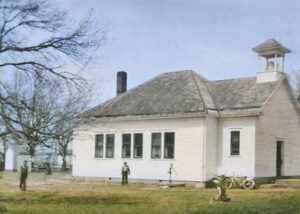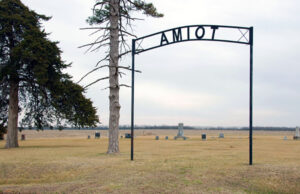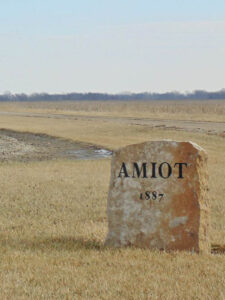Amiot, Kansas, was a village in Reeder Township, in the extreme western part of Anderson County. Today, it is an abandoned town with no remains other than a stone marker.
In early 1856, settlers arrived in northwestern Anderson County, settling near a high hill known as Mineral Point. It was called such because coal deposits had been discovered on the hill. Solomon Kauffman and Joseph J. Ingliss were some of the first settlers, arriving on May 17, 1856. They liked the high terrain, which gave them a good view and the advantage of seeing any hostile Indians or pro-slavery raiders in the area.
Other early settlers were pro-slavery sympathizers. However, they packed and returned to Missouri when they heard John Brown and his men had killed five pro-slavery sympathizers along the Pottawatomie River. In August 1856, the first settlers, Solomon Kauffman and Joseph Ingliss, left and went to Lawrence, Kansas, to enlist in the Free State cause. Others also fled the area, leaving only two families in the neighborhood — the Bobiers and the Carls.
Several settlers arrived in the spring of 1857. S.S. Tipton had built a large three-story house of local stone with a store serving as a stage stop. The stone was crafted with loopholes to defend the house against attacking Indians.
On July 4, 1857, a large celebration was held on the hill where S.S. Tipton lived. That day, a military company with 31 members was formed, with J. Aliff as Captain, L.L. Hayden as First Lieutenant, and J.H. Hadley as Second Lieutenant.
A post office was established in the stagecoach stop in S.S. Tipton’s home on September 30, 1862, and Tipton became the first postmaster. The stagecoach line ran through Mineral Point from Leavenworth through Hyatt, Cresco, to Mineral Point, and then to Dodge City.
A cemetery was established in 1878, about a mile north of the stage stop, and a Presbyterian Church was built next to it at about the same time.
Until the Kansas, Nebraska, and Dakota Railroad arrived, the area was a quiet farming community. In 1886-1887, railroad tracks were laid, and a siding was built three miles north of the settlement. Mineral Point then moved to the railroad, and John Knight built a general store alongside the tracks and soon became \the railroad agent at the new depot. The Presbyterian Church was moved from the cemetery north to the townsite, and the post office was moved from the stage station to the new town. The post office retained its name of Mineral Point. However, the post office closed on February 3, 1887, and moved to Harris.
The post office reopened on April 5, 1905, and its name was changed to Amiot.
In 1910, it was a station on the Missouri Pacific Railroad, not far from the Coffey County line. At that time, it had a money order post office, was a trading and shipping point, and had a population of 40.
Amiot’s post office closed on September 30, 1951.
By 1964, the only remaining buildings in Amiot were the old schoolhouse and one residence.
Today, there are no remains of the town except a marker. The Amiot cemetery, also called the Baird Cemetery, is nearby.
Amiot was located about 16 miles northwest of Garnett.
© Kathy Alexander/Legends of Kansas, updated October 2024.
Also See:
Extinct Towns in Anderson County
Sources:
1878 Gazetteer and Business Directory, R. L. Polk & Co., Chicago, IL.
Anderson County Historical Society
Blackmar, Frank W.; Kansas: A Cyclopedia of State History, Vol I; Standard Publishing Company, Chicago, IL 1912.
Cutler, William G; History of Kansas; A. T. Andreas, Chicago, IL, 1883.
Kansas State Historical Society – Post Offices



